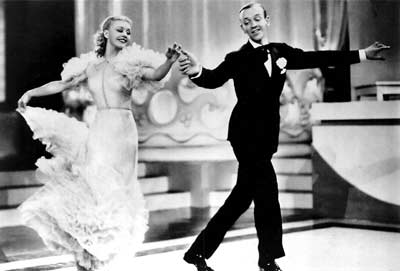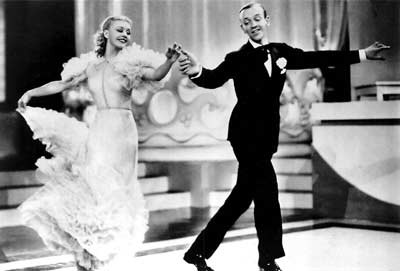Backwards and In Heels: Why Women Make Better Attorneys
They say Ginger Rogers could do everything Fred Astaire could . . . just backwards and in heels. Like many women, Ginger was handicapped by heels and social conventions that increased the complexity of her part in the “dance.” Despite these drawbacks, Ginger achieved excellence; she proved she could dance well, no matter how hard they made it for her.
In the dance of Law, women also achieve excellence despite distinct disadvantages that their male counterparts simply do not share. Not only do women lawyers slog around in inhumane heels, they also practice under physical and social conditions that render their accomplishments comparatively more impressive than their male peers. For example:
-
Obtaining the relief you sought in an hour-long motions hearing . . . impressive;
-
Obtaining the relief you sought in an hour-long motions hearing with boobs bursting because you expected the hearing to last 15 minutes and did not pump beforehand . . . more impressive.
or,
- Getting a “not guilty” verdict after a week-long criminal trial . . . impressive;
- Getting a “not guilty” verdict after a week-long criminal trial in which your kids, including your husband, had the flu and required constant care . . . more impressive;
or,
- Meeting the monthly billable hour requirement . . . [not very] impressive;
- Meeting the monthly billable hour requirement despite being on bedrest for a high risk pregnancy . . . more impressive.
or, what about this:
-
Writing a winning summary judgment motion . . . impressive;
-
Writing a winning summary judgment motion with a Scooby Do marathon blaring in the background . . . more impressive;
and, of course, this:
-
Settling a high risk case favorably for your client . . . impressive;
-
Settling a high risk case favorably for your client at the Playland at McDonalds . . . more impressive;
we surely cannot forget:
-
Giving a terrific, well-received presentation at a bar association luncheon . . . impressive;
- Giving a terrific, well-received presentation at a bar association luncheon with baby puke covering the front of your blouse . . . more impressive.
Now, many male attorneys with kids may understandably cry FOUL and accurately point out that some of these examples showcase the burdens of parenthood, not just womanhood. And, to some extent, they would be correct. But to suggest that parenthood affects the careers male and female attorneys equally, or even equitably, would simply be disingenuous. As many could attest, a female attorney who brings her sick child to work is often viewed contemptuously as having a childcare problem; a male attorney, by contrast, is often hailed as Father of the Year under the exact same circumstances. In fact, parenthood has become the Black Hole sucking talented women from Law for one simple reason: the mostly male management of law firms has seen no reason to accommodate the realities of women’s lives (e.g., fertility, family, multi-functioning), thereby forcing them into cruel choices that they should not need to make–i.e., do I suck as a mother or an attorney today? For high achieving women with the kind of Type A personalities that drive them into law school, that choice–namely, how to suck on any given day–is simply crazy-making.
But even beyond parenthood, women who have achieved excellence and/or equity partnership in Law (and those two are certainly not the same) have done so despite deep institutional disadvantages. For example, consider these real life examples:
-
Representing a Muslim GITMO detainee pro bono . . . impressive;
-
Representing pro bono a Muslim GITMO detainee who will not look you in the face because of your inferiority as a woman . . . more impressive, if not SHE-roic.
or,
- Landing and retaining for two years a large institutional client . . . impressive;
- Landing and retaining a large institutional client in your book for two years, despite your male peers’ efforts to claim origination credit or to filch it at football games, golf outings, strip clubs or during other more gentlemanly (i.e. Law Frat) pursuits . . . more impressive.
or, even this
- Keeping your cool when an elderly federal judge on senior status yells at you about trial scheduling conflicts . . . impressive.
- Keeping your cool when an elderly federal judge on senior status yells that family conflicts should not stand in the way of setting a trial because (paraphrased) as a woman, you should have anticipated these problems when you spawned with your law school sweetheart . . . more impressive.
Many of these things have happened to me in my 12 years at BIGLAW. More importantly, I have heard countless stories of female attorneys accomplishing truly amazing feats in their careers, but then quitting the practice in frustration and feelings of failure (i.e., I suck at everything, home and work). In fact, given the hurdles female attorneys surmount every day, they have actually developed skills and meta-skills that make them more effective project managers, stronger advocates, better client hand-holders, more reliable deliverers, and certainly more efficient billers. As another old saying goes,
if you want something done well and on time, give it to someone who is really busy.
Women, particularly moms, are accustomed to juggling competing demands and deadlines. We have grown accustomed to performing well under truly unusual circumstances. We have unrivaled resourcefulness. We’re too busy to run up a client’s bill, spending an inordinate amount of time on a single legal project. In fact, as mothers, we have sprouted extra appendages that allow us to carry briefcases and breast pumps . . . while wheeling a litigation bag . . . backwards and in heels. Almost paradoxically, what many male decision-makers at BIGLAW perceive as our greatest liabilities as female attorneys (e.g., our fertility, families, feelings, multi-functioning) are actually our greatest assets as attorneys.
In so many ways, women make better lawyers. The traditional law firm model, however, elevates the billed attorney over the skilled attorney able to deftly, quickly resolve the client’s problem. Fortunately, corporations—particularly the growing legion of female in-house counsel—are starting to realize that the traditional law firm model that they too escaped is riddled with inefficiencies, inefficiencies that technology can fix. Wth technology, small “Mom Firms” can compete on equally footing with BIGLAW, and deliver legal services more efficiently, without the heavy infrastructure resulting in unreasonable rates. It’s funny: since leaving BIGLAW to launch my little Mom Firm in June of 2012, I’m on course to bill half the hours and make twice the money.
Women, particularly moms, will likely never achieve full equality with men under a traditional law firm model. The question now is how we’re going to use our incredible skills, talents, resourcefulness, ingenuity, and juggling ability to redefine and improve how legal services are delivered, and almost more importantly, how future generations of talented female attorneys will make their lives work. With technology and a Law Firm 2.0 model, female attorneys can remain in the game, while chucking the shackles of a 2,000 annual billable requirement and the quiet desperation of doing everything backwards and in heels. It’s time.
Please share your own backwards and in heels story.  below.
below.

An impressive share! I’ve just forwarded this onto a coworker who had been conducting a little research on this. And he actually bought me dinner due to the fact that I found it for him… lol. So let me reword this…. Thank YOU for the meal!! But yeah, thanx for spending time to discuss this subject here on your web site.